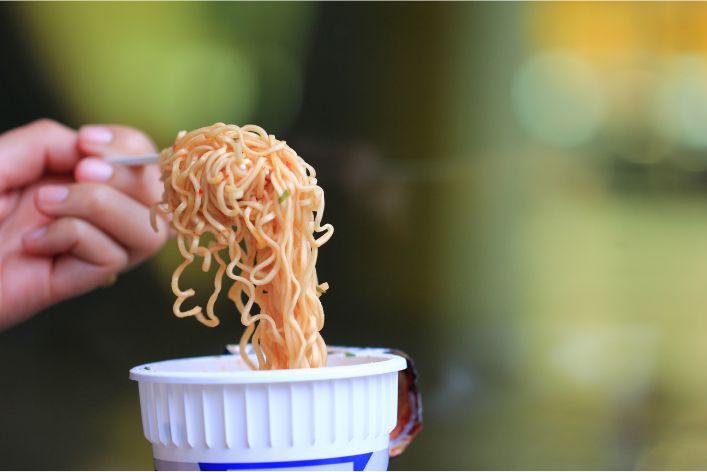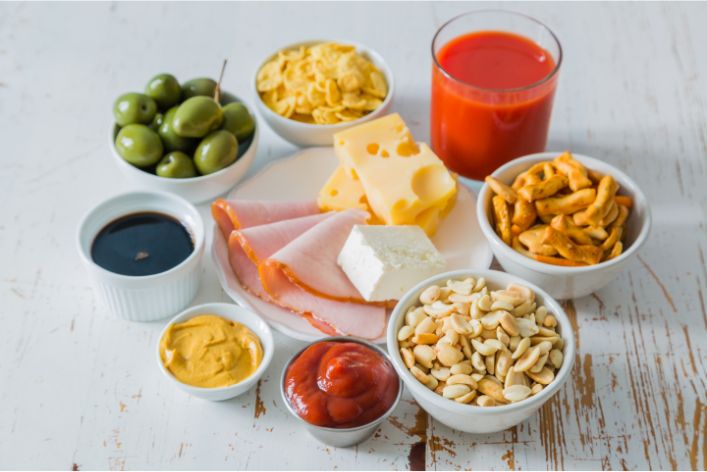Excessive sodium intake, which is common in a high-sodium diet, is a significant issue in the modern world. This is due to a variety of factors, including the widespread availability of processed and fast food, which often contains unhealthy amounts of salt. As a result, reducing salt intake has become a priority for public health officials and medical professionals.
Reducing salt intake is important because high levels of sodium can have negative impacts on health. For example, it can cause hypertension, which is a major risk factor for cardiovascular events such as heart attacks and strokes. In addition, excessive sodium intake can also lead to chronic kidney disease, osteoporosis, and other health problems.

Moreover, recent studies have suggested that even moderate reductions in sodium intake can have significant benefits for health. For example, reducing sodium intake by just 1,000 mg per day can lower blood pressure and reduce the risk of cardiovascular events by up to 25%.
Reducing salt intake is crucial for maintaining good health, particularly in the face of a high-sodium diet. By making positive changes to our dietary habits, we can lower our risk of numerous health problems and ensure a better quality of life.
Read: Staying Hydrated: Tips for Better Athletic Performance
Understanding Sodium and Salt in the Diet
Sodium and salt are two terms that are often used interchangeably. Although they are related, they have different meanings. Sodium is an essential mineral that our body needs to function properly, while salt is a compound made up of sodium and chloride. In this chapter, we will discuss the sources of sodium and salt in the diet and how much should be consumed on a daily basis.
Definition of Sodium and Salt
Sodium is one of the most abundant elements on earth and is an essential mineral that plays a vital role in the human body. It regulates fluid balance, helps with nerve function, and assists in muscle contraction. Salt, on the other hand, is a compound made up of sodium and chloride. It is commonly used as a seasoning in food to enhance flavor.
Sources of Sodium and Salt in the Diet
- Processed Foods: The majority of sodium in the American diet comes from processed foods such as packaged snacks, canned soups, and frozen meals.
- Restaurant Foods: Many restaurant foods are high in sodium due to the use of seasonings, sauces, and marinades.
- Bread and Baked Goods: Bread, rolls, and other baked goods can be high in sodium due to the use of salt in the dough.
- Cured Meats: Cured meats such as deli meats, bacon, and sausage are high in sodium to help preserve them.
- Cheese: Cheese can be high in sodium, especially processed cheese.
Recommended Daily Intake of Sodium
The American Heart Association recommends that adults consume no more than 2,300 milligrams of sodium per day, which is about one teaspoon of salt. However, the ideal intake is 1,500 milligrams per day for most adults, especially those with hypertension, diabetes, or kidney disease.
Consuming too much sodium can lead to health problems such as high blood pressure, heart disease, and stroke. Therefore, it is important to be aware of the sodium content in the foods we consume and to limit our intake of processed and restaurant foods.
In conclusion, sodium and salt are essential components of our diet, but excessive intake can have negative effects on our health. By being mindful of the sources of sodium and salt in our diet and limiting our intake, we can improve our overall well-being.
Read: Hidden Dangers: What to Avoid in Processed Foods
Negative Effects of High Sodium Intake
Consuming too much sodium can have serious negative effects on your health. Here are some of the most significant risks associated with high sodium intake:
Increased risk for hypertension
High sodium intake has been linked to high blood pressure or hypertension. When you consume too much salt, your body retains more water to try and dilute the excess sodium. This puts a strain on your blood vessels, leading to higher blood pressure and an increased risk of heart attack or stroke.
Increased risk for heart disease and stroke
In addition to hypertension, high sodium intake can cause other cardiovascular problems. Studies have shown that people who consume high amounts of sodium have a greater risk for developing heart disease and stroke, even if they don’t have hypertension. These conditions can be debilitating and life-threatening, so it’s important to be mindful of your sodium intake.
Effects on kidney function and bone health
Excessive sodium intake can also have negative effects on your kidneys and bones. Your kidneys play a vital role in regulating your body’s sodium levels, but too much sodium can cause them to work harder than they should, leading to kidney damage over time. Additionally, a high-sodium diet can cause your body to lose calcium, which can weaken your bones and lead to osteoporosis.
To avoid these negative effects, it’s important to limit your sodium intake. Current guidelines recommend consuming less than 2,300 milligrams of sodium per day, while some health experts suggest an even lower limit of 1,500 milligrams per day for certain populations, such as people with hypertension or kidney problems.
Some easy ways to reduce your sodium intake include cooking at home more often, using fresh herbs and spices instead of salt to flavor your food, and choosing low-sodium products at the grocery store. By being mindful of your sodium intake, you can protect your health and reduce your risk for serious health problems.
Read: What Preventative Health Care Steps Should You Take?
Ways to Reduce Salt Intake
Reducing salt intake can have numerous health benefits. High sodium levels can lead to high blood pressure, heart disease, and stroke. But reducing salt in your diet doesn’t mean sacrificing flavor. By making a few simple changes, you can keep your food tasty and healthy.
Choose Lower-Sodium Options When Shopping for Food
When buying groceries, pay attention to the sodium content in packaged foods. Choose options labeled “low sodium” or “reduced sodium,” or compare brands to find the one with the lowest amount of salt. This can make a big difference in your overall salt intake.
Use Herbs and Spices Instead of Salt to Add Flavor to Meals
Herbs and spices can add lots of flavor to foods without adding salt. Experiment with different combinations like garlic, rosemary, and thyme on vegetables, or cumin and chili powder on meats. Try making your own spice blends to add variety to your meals.
Reduce Consumption of Salty Snacks and Processed Foods
Processed and packaged foods tend to be high in sodium. Avoiding salty snacks like chips, pretzels, and popcorn, as well as foods like canned soup, frozen meals, and deli meats can significantly reduce your salt intake. Eating whole, fresh foods is a healthier option and can be just as delicious.
Be Mindful of Condiments and Sauces that May Contain High Amounts of Sodium
Many condiments and sauces, like ketchup and soy sauce, are high in sodium. Be mindful of how much you’re using and look for low-sodium versions or alternatives like mustard or hot sauce. Additionally, when eating out, ask for condiments on the side so you can control how much you’re adding to your meal.
Reducing salt in your diet may take some getting used to, but it’s well worth the effort. By choosing lower sodium options, using herbs and spices instead of salt, avoiding salty snacks and processed foods, and being mindful of condiments, you’ll improve your health and still enjoy delicious meals.
Read: How to Lower Your Blood Pressure Naturally

Tips for Eating Out with a High-Sodium Diet
Eating out can be a challenge when you’re sticking to a high-sodium diet. Many restaurant meals are packed with salt and it can be difficult to know which options are safe. But with a bit of preparation and mindfulness, you can still enjoy dining out without sacrificing your health goals. Here are some tips to help you navigate the menu and make smart choices:
1. Research restaurants and menu options beforehand
- Use websites like Yelp or OpenTable to read reviews and check menus
- Look for dishes labeled as low-sodium or heart-healthy
- Some chain restaurants may have nutrition information available online
2. Ask for dressings and sauces on the side
- Many restaurant dishes come coated in salty sauces and dressings
- Ask for these condiments on the side so you can control the amount you consume
- You may also want to ask for a low-sodium alternative if available
3. Avoid adding salt to meals before trying them
- Many people automatically reach for the salt shaker when their food arrives
- Wait until you’ve tasted the dish before adding any extra sodium
- Many restaurant meals are already high in salt, so don’t add more than necessary
4. Stick to simple preparations
- Complex dishes like creamy plates of pasta or heavily seasoned meats often contain a lot of sodium
- Stick to simpler preparations like grilled or baked options
- Opt for fresh vegetables and fruits as sides instead of salt-laden fries or chips
5. Be assertive with your server
- Don’t be afraid to ask your server about sodium levels or to make special requests
- Ask if dishes can be prepared with less salt or if substitutions can be made
- Your server can be a helpful resource, so don’t hesitate to speak up
With these tips in mind, you can still enjoy a meal out while keeping your sodium intake in check. Remember to do your research, be assertive, and stay mindful of your choices. Cheers to happy and healthy dining!
Read: What is Creatine and Is it Healthy?
Conclusion
High sodium intake has negative effects on our health. These effects include an increased risk of high blood pressure, heart disease, stroke, and kidney damage.
Therefore, reducing salt intake in a high-sodium diet is crucial. It’s important to read food labels and choose low-sodium options. Also, avoid adding extra salt to food during cooking or at the table.
Simple lifestyle changes can help reduce sodium intakes, such as cooking with herbs and spices instead of salt, limiting processed foods, and increasing the consumption of fresh fruits and vegetables.
Encouraging readers to make small changes towards reducing their salt intake can have a significant impact on their health. Let’s work towards making healthier choices and reducing our sodium intake for a better and healthier life.
Read: The Top 10 Superfoods You Need to Include in Your Diet
Before You Go…
Hey, thank you for reading this blog to the end. I hope it was helpful. Let me tell you a little bit about Nicholas Idoko Technologies. We help businesses and companies build an online presence by developing web, mobile, desktop, and blockchain applications.
We also help aspiring software developers and programmers learn the skills they need to have a successful career. Take your first step to becoming a programming boss by joining our Learn To Code academy today!
We Design & Develop Websites, Android & iOS Apps
Looking to transform your digital presence? We specialize in creating stunning websites and powerful mobile apps for Android and iOS. Let us bring your vision to life with innovative, tailored solutions!
Get Started TodayBe sure to contact us if you need more information or have any questions! We are readily available.
Put Your Tech Company on the Map!
Get featured on Nicholas Idoko’s Blog for just $200. Showcase your business, boost credibility, and reach a growing audience eager for tech solutions.
Publish Now










